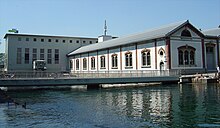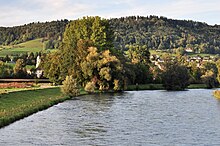| Revision as of 13:47, 13 May 2014 editUlamm (talk | contribs)Extended confirmed users4,731 editsmNo edit summary← Previous edit | Revision as of 13:48, 13 May 2014 edit undoUlamm (talk | contribs)Extended confirmed users4,731 editsNo edit summaryNext edit → | ||
| Line 5: | Line 5: | ||
| | caption = The Limmat in Zurich, looking downstream from Lake Zurich | | caption = The Limmat in Zurich, looking downstream from Lake Zurich | ||
| | origin = ], ] | | origin = ], ] | ||
| | mouth = ] | | mouth = ] | ||
| | basin_countries = Switzerland | | basin_countries = Switzerland | ||
| | image_map = Karte Limmat.png | | image_map = Karte Limmat.png | ||
Revision as of 13:48, 13 May 2014
This article is about the river. For the ship on Lake Zurich, see Limmat (ship, 1958). River| Limmat | |
|---|---|
 | |
| Physical characteristics | |
| Mouth | Aare |
| Length | 35 kilometres (22 mi) |






The Limmat is a river in Switzerland. The river commences at the outfall of Lake Zurich, in the centre of the city of Zurich. From Zurich it flows in a northwesterly direction, after 35 km reaching the river Aare. The confluence is located north of the small town of Brugg and shortly after the mouth of the Reuss.
The main towns along the Limmat Valley downstream of Zurich are Dietikon, Wettingen, and Baden. Its main tributaries are the Linth, via Lake Zurich, the Sihl, in Zurich, and the Reppisch, in Dietikon.
The hydronym is first attested in the 8th century, as Lindimacus. It is of Gaulish origin, from *lindo- "lake" and *magos "plain", and was thus presumably in origin the name of the plain formed by the Linth river.
Power generation
Like many Swiss rivers, the Limmat is intensively used for production of hydroelectric power: along its course of 35 km (22 mi), its fall is used by no less than ten hydroelectric power stations. These include:
| This list is incomplete; you can help by adding missing items. (April 2013) |
Navigation
Historically, the Limmat was an important navigation route. In the twelfth and thirteenth centuries, voyages from Zurich to Koblenz are recorded. In 1447, the Emperor Frederick III granted the privilege of free navigation on the Limmat and on the Rhine to Zurich. Because of the current, navigation was typically downstream only, with the barges being sold on arrival.
Today, the Limmat is navigable for much of its length by small craft only, with many of the hydroelectric power plants incorporating boat lifts. The traditional boat type used on the river is the weidling, a flat-bottomed vessel that is usually 10 metres (33 ft) long.
The uppermost stretch of the river through the centre of Zurich is navigable by rather larger vessels, albeit limited by low bridges. On this stretch of the river the Zürichsee-Schifffahrtsgesellschaft (Lake Zurich Navigation Company) operates its Limmat boat service, from the Landesmuseum to Lake Zurich, using low-profile motor boats.
Towns near the river
- In the canton of Zurich:
- In the canton of Aargau
References
- Felix Stähelin (1935), "Die vorrömische Schweiz im Lichte geschichtlicher Zeugnisse und sprachlicher Tatsachen", Zeitschrift für schweizerische Geschichte, vol. Band 15, Leemann, pp. 337–368
- ^ "Limmat Power Generation". Regional Werke AG Baden. Retrieved 2013-04-25.
- "Flusskraftwerk Dietikon". Elektrizitätswerke des Kantons Zürich. Retrieved 2013-04-25.
- "Kraftwerk Höngg". City of Zurich. Retrieved 2013-04-25.
- "Kraftwerk Letten". City of Zurich. Retrieved 2013-04-25.
- "Kraftwerk Wettingen". City of Zurich. Retrieved 2013-04-25.
- "Limmat". Historical Dictionary of Switzerland (in German). Retrieved 2013-04-24.
- "Funicular Boat Lifts of Switzerland". funimag.com. Retrieved 2013-04-24.
- "Clubportrait Schiffe" (in German). Retrieved 2013-04-24.
- "Limmat river cruises". Zürichsee-Schifffahrtsgesellschaft. Retrieved 2013-04-24.
External links
 Media related to Limmat at Wikimedia Commons
Media related to Limmat at Wikimedia Commons Media related to Limmat in Zürich at Wikimedia Commons
Media related to Limmat in Zürich at Wikimedia Commons- Limmat in German, French and Italian in the online Historical Dictionary of Switzerland.
47°30′N 8°15′E / 47.500°N 8.250°E / 47.500; 8.250
Categories:
